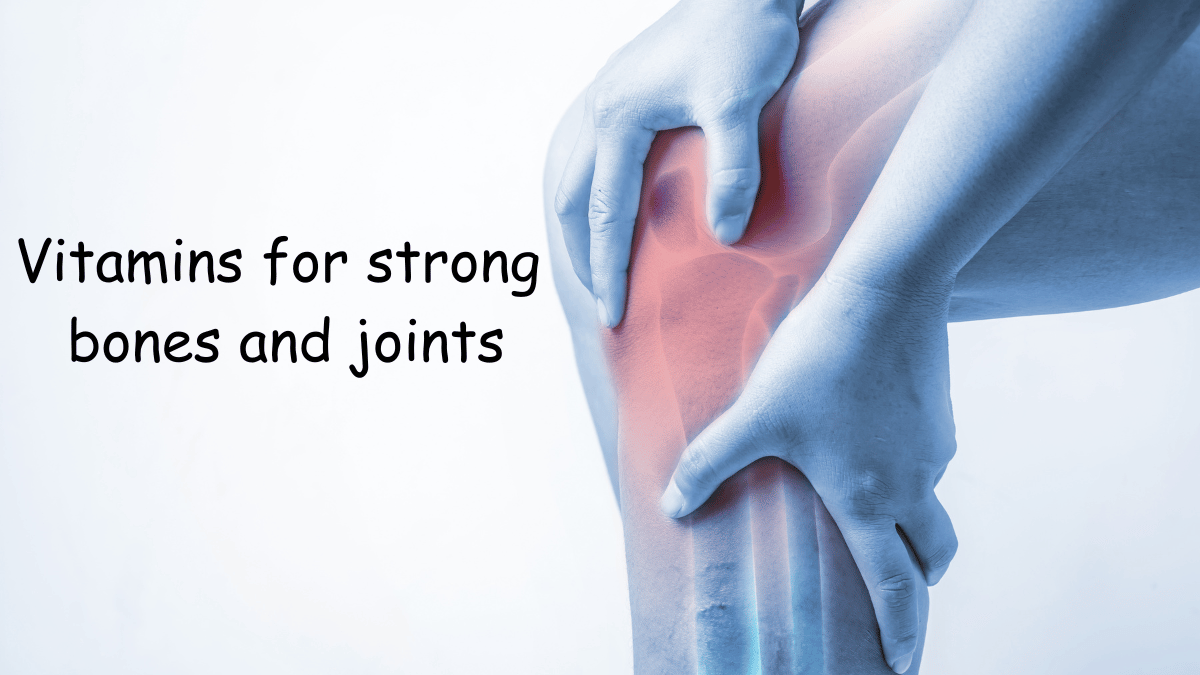Essential Vitamins for strong Bone and joints Health
Vitamin D
Role in Calcium Absorption
Vitamin D is crucial for bone health because it enhances the body’s ability to absorb calcium from the diet. Without sufficient vitamin D, calcium absorption is impaired, which can lead to weakened bones and an increased risk of fractures.
Sources and Recommended Intake:
- Sources: Sunlight exposure is a natural source of vitamin D, as the skin synthesizes it when exposed to UV rays. Dietary sources include fatty fish (like salmon and mackerel), liver, egg yolks, fortified foods (such as milk, orange juice, and cereals), and vitamin D supplements.
- Recommended Intake: The Recommended Dietary Allowance (RDA) for vitamin D varies by age, gender, and life stage. For most adults, it is 600-800 IU (15-20 micrograms) per day. However, higher doses may be recommended for those with deficiencies or specific health conditions, but this should be determined by a healthcare provider.
Vitamin K
Role in Bone Mineralization:
Vitamin K is vital for bone health as it helps regulate calcium within the bones and blood. It is essential for the synthesis of osteocalcin, a protein that binds calcium to the bone matrix, thus aiding in bone mineralization and strength.
Sources and Recommended Intake:
- Sources: Vitamin K is found in leafy green vegetables (like spinach, kale, and broccoli), fish, meat, dairy products, and fermented foods (such as natto, a fermented soybean product).
- Recommended Intake: The RDA for vitamin K is 90 micrograms per day for adult women and 120 micrograms per day for adult men. As with vitamin D, specific needs may vary based on individual health conditions.
Vitamin C
Role in Collagen Production:
Vitamin C is essential for the synthesis of collagen, a key protein that provides structural support to bones and connective tissues. Adequate vitamin C levels help maintain bone strength and integrity by supporting the health of bone matrix and cartilage.
Sources and Recommended Intake:
- Sources: Rich sources of vitamin C include citrus fruits (oranges, lemons), strawberries, bell peppers, tomatoes, and green leafy vegetables.
- Recommended Intake: The RDA for vitamin C is 75 milligrams per day for adult women and 90 milligrams per day for adult men. Higher doses may be needed for those with specific conditions or deficiencies.
Vitamin A
Role in Bone Remodeling:
Vitamin A plays a role in bone remodeling by regulating the activities of osteoblasts (cells that form new bone) and osteoclasts (cells that break down old bone). It helps balance bone formation and resorption, which is crucial for maintaining bone density and health.
Sources and Recommended Intake:
- Sources: Vitamin A can be obtained from animal sources (liver, fish oils, eggs, and dairy products) and plant sources (carrots, sweet potatoes, and leafy greens, which contain beta-carotene that the body converts to vitamin A).
- Recommended Intake: The RDA for vitamin A is 700 micrograms per day for adult women and 900 micrograms per day for adult men. Overconsumption of vitamin A, particularly in supplement form, can be toxic, so it’s essential to follow recommended guidelines.

Essential Vitamins for Joint Health
Vitamin B6
Role in Reducing Inflammation:
Vitamin B6 (pyridoxine) plays a role in reducing inflammation, which can benefit joint health. It is involved in the synthesis of neurotransmitters and proteins that help modulate inflammatory responses. Additionally, vitamin B6 can assist in reducing symptoms of joint pain by supporting overall metabolic processes and immune function.
Sources and Recommended Intake:
- Sources: Good dietary sources of vitamin B6 include poultry (such as chicken and turkey), fish (like salmon and tuna), potatoes, bananas, chickpeas, and fortified cereals.
- Recommended Intake: The Recommended Dietary Allowance (RDA) for vitamin B6 is 1.3-2.0 milligrams per day for adults, depending on age and gender. For example, adult women need about 1.3-1.5 milligrams per day, while adult men need 1.3-2.0 milligrams per day. Higher doses may be used in some therapeutic contexts, but this should be done under medical supervision to avoid toxicity.
Vitamin B12
Role in Joint Health and Pain Reduction:
Vitamin B12 (cobalamin) is important for joint health because it contributes to the production of red blood cells and nerve function. Deficiency in vitamin B12 can lead to neurological issues, which may manifest as joint pain or discomfort. Additionally, vitamin B12 plays a role in reducing homocysteine levels, an amino acid that, when elevated, can be associated with an increased risk of joint and bone issues.
Sources and Recommended Intake:
- Sources: Vitamin B12 is primarily found in animal products such as meat, fish, poultry, eggs, and dairy products. Fortified foods and supplements are alternative sources for those on a vegetarian or vegan diet.
- Recommended Intake: The RDA for vitamin B12 is 2.4 micrograms per day for adults. For older adults and those with absorption issues, higher doses might be needed, which can be managed through supplementation or dietary adjustments.
How Vitamins Work Together
- Vitamins often work together synergistically to support bone and joint health. Their interactions can enhance their individual benefits and contribute to overall well-being. Here’s how vitamins collaborate and why a balanced diet is essential:
- Synergistic Effects on Bone and Joint Health
- Vitamin D and Calcium:
- Interaction: Vitamin D enhances the absorption of calcium in the intestines. Calcium, in turn, is crucial for bone formation and strength. Without adequate vitamin D, the body cannot effectively use calcium, even if dietary intake is sufficient.
- Effect: Combined, vitamin D and calcium support bone mineralization and help prevent conditions like osteoporosis.
- Vitamin K and Vitamin D:
- Interaction: Vitamin K works in conjunction with vitamin D to regulate calcium use in the body. Vitamin K helps activate osteocalcin, a protein that binds calcium to the bone matrix, while vitamin D ensures that calcium is adequately absorbed.
- Effect: This synergy helps maintain bone density and strength, reducing the risk of fractures.
- Vitamin C and Collagen Production:
- Interaction: Vitamin C is essential for the synthesis of collagen, a key protein that supports the structure of bones, cartilage, and ligaments. Collagen provides the matrix for bone mineralization and cartilage integrity.
- Effect: Adequate vitamin C levels contribute to healthy joints and connective tissues, which can reduce joint pain and support overall joint function.
- Vitamin B6 and Vitamin B12:
- Interaction: Both vitamins B6 and B12 are involved in reducing levels of homocysteine, an amino acid that, when elevated, is linked to an increased risk of joint and bone problems. They also support nerve function and reduce inflammation.
- Effect: Together, these vitamins help manage inflammation and support nerve health, which is beneficial for joint pain reduction and overall joint health.
- Importance of a Balanced Diet
- Nutrient Balance:
A balanced diet ensures that you get a wide range of vitamins and minerals in appropriate amounts. This balance is crucial because vitamins often interact with each other, and deficiencies or excesses of one vitamin can affect the function and absorption of others. - Preventing Deficiencies:
A varied diet helps prevent deficiencies in essential vitamins and minerals, which can lead to bone and joint issues. For example, lacking vitamin D can lead to poor calcium absorption, while insufficient vitamin K can impair bone mineralization. - Supporting Overall Health:
Besides bone and joint health, a balanced diet supports other aspects of overall health, including immune function, cardiovascular health, and energy levels. This holistic approach contributes to better quality of life and reduces the risk of chronic diseases. - Dietary Diversity:
Including a variety of foods in your diet ensures that you receive all the necessary nutrients. For example, fruits and vegetables provide vitamins C and K, while dairy products and fortified foods offer vitamin D. Whole grains, meats, and legumes supply B vitamins.
Recommended Daily Intakes
- Understanding the recommended daily intakes for essential vitamins and choosing between supplementation and dietary sources are crucial for maintaining optimal bone and joint health. Here’s a detailed guide on these aspects:
- Age and Gender Specific Guidelines

Vitamin D:
- Infants (0-12 months): 400 IU (10 mcg) per day.
- Children (1-18 years): 600 IU (15 mcg) per day.
- Adults (19-70 years): 600 IU (15 mcg) per day.
- Adults (71+ years): 800 IU (20 mcg) per day.
- Pregnant and Lactating Women: 600 IU (15 mcg) per day.
Vitamin K:
- Infants (0-6 months): 2.0 micrograms per day.
- Children (1-3 years): 30 micrograms per day.
- Children (4-8 years): 55 micrograms per day.
- Children (9-13 years): 60 micrograms per day.
- Teenagers (14-18 years): 75 micrograms per day for females, 75 micrograms per day for males.
- Adults (19-50 years): 90 micrograms per day for females, 120 micrograms per day for males.
- Adults (51+ years): 90 micrograms per day for females, 120 micrograms per day for males.
- Pregnant and Lactating Women: 90 micrograms per day.
Vitamin C:
- Infants (0-6 months): 40 milligrams per day.
- Children (1-3 years): 15 milligrams per day.
- Children (4-8 years): 25 milligrams per day.
- Children (9-13 years): 45 milligrams per day.
- Teenagers (14-18 years): 65 milligrams per day for females, 75 milligrams per day for males.
- Adults (19+ years): 75 milligrams per day for females, 90 milligrams per day for males.
- Pregnant Women: 85 milligrams per day.
- Lactating Women: 120 milligrams per day.
Vitamin B6:
- Infants (0-6 months): 0.1 milligrams per day.
- Children (1-3 years): 0.3 milligrams per day.
- Children (4-8 years): 0.5 milligrams per day.
- Children (9-13 years): 1.0 milligrams per day.
- Teenagers (14-18 years): 1.2 milligrams per day for females, 1.3 milligrams per day for males.
- Adults (19-50 years): 1.3 milligrams per day for females, 1.3-2.0 milligrams per day for males.
- Adults (51+ years): 1.5 milligrams per day for females, 1.7 milligrams per day for males.
- Pregnant Women: 1.9 milligrams per day.
- Lactating Women: 2.0 milligrams per day.
Vitamin B12:
- Infants (0-6 months): 0.4 micrograms per day.
- Children (7-12 months): 0.5 micrograms per day.
- Children (1-3 years): 0.9 micrograms per day.
- Children (4-8 years): 1.2 micrograms per day.
- Children (9-13 years): 1.8 micrograms per day.
- Teenagers (14-18 years): 2.4 micrograms per day.
- Adults (19+ years): 2.4 micrograms per day.
- Pregnant Women: 2.6 micrograms per day.
- Lactating Women: 2.8 micrograms per day.
- Supplementation vs. Dietary Sources
Dietary Sources:
Advantages:
- Nutrient Diversity: Whole foods provide a range of nutrients, including vitamins, minerals, fiber, and antioxidants, which work together to support health.
- Better Absorption: Nutrients from food are often better absorbed and utilized by the body compared to supplements.
- Lower Risk of Overconsumption: It’s harder to consume excessive amounts of vitamins through food alone, reducing the risk of toxicity.
- Disadvantages:
- Varied Intake: Depending on dietary preferences or restrictions, it might be challenging to get all essential vitamins from food alone.
- Supplementation:
Advantages:
- Targeted Nutrient Boost: Supplements can help fill gaps in the diet, especially for those with specific deficiencies or increased needs.
- Convenience: Easier to manage intake levels and ensure consistency.
- Disadvantages:
- Risk of Overconsumption: Excessive intake of supplements can lead to toxicity, particularly with fat-soluble vitamins (A, D, E, K).
- Less Nutrient Diversity: Supplements typically provide isolated nutrients without the additional beneficial compounds found in whole foods.
Potential Deficiencies and Their Impact
Common Deficiencies and Symptoms
Vitamin D:
- Deficiency Symptoms: Fatigue, bone pain, muscle weakness, increased risk of fractures, and in severe cases, rickets in children or osteomalacia in adults.
- Impact: Reduced calcium absorption leading to weakened bones and an increased risk of osteoporosis and fractures.
Vitamin K:
- Deficiency Symptoms: Easy bruising, excessive bleeding, and poor wound healing. In severe cases, it can lead to bleeding disorders.
- Impact: Impaired bone mineralization and increased risk of fractures. Inadequate vitamin K also affects blood clotting, leading to increased bleeding risk.
Vitamin C:
- Deficiency Symptoms: Scurvy, characterized by bleeding gums, joint pain, and poor wound healing. Symptoms can also include fatigue and depression.
- Impact: Impaired collagen synthesis, which affects the health of bones, cartilage, and connective tissues, potentially leading to joint pain and weakened bones.
Vitamin B6:
- Deficiency Symptoms: Anemia, irritability, depression, confusion, and muscle pain. Severe deficiency can lead to neurological issues such as neuropathy.
- Impact: Disrupted protein metabolism and neurotransmitter function, which can affect mood and nerve function. It may also contribute to joint inflammation and pain.
Vitamin B12:
- Deficiency Symptoms: Fatigue, weakness, memory loss, and neurological issues such as numbness and tingling in the hands and feet. In severe cases, it can lead to anemia.
- Impact: Disruption of red blood cell formation and nerve function. Neurological symptoms can include joint pain and discomfort due to impaired nerve signaling.
Risks of Over-Supplementation
- Vitamin D:
- Risks: Excessive vitamin D can lead to hypercalcemia (high calcium levels in the blood), which may cause nausea, vomiting, weakness, and kidney damage. Long-term high doses can also lead to calcification of soft tissues.
- Vitamin K:
- Risks: Over-supplementation, particularly with synthetic vitamin K (K3), can affect blood clotting and potentially interact with anticoagulant medications, increasing the risk of bleeding or clotting issues.
- Vitamin C:
- Risks: High doses can lead to gastrointestinal disturbances, such as diarrhea and abdominal cramps. In rare cases, excessive intake can cause kidney stones, especially in those with a history of kidney issues.
- Vitamin B6:
- Risks: High doses can cause neuropathy (nerve damage), which may result in numbness, tingling, or muscle weakness. Symptoms usually resolve after reducing intake, but prolonged high doses can lead to permanent damage.
- Vitamin B12:
- Risks: Generally considered safe even at high doses, but excessive amounts from supplements can mask vitamin B9 (folate) deficiency, which may lead to anemia.
Tips for Incorporating Vitamins into Your Diet
Food Sources
- Vitamin D:
- Foods: Fatty fish (e.g., salmon, mackerel), cod liver oil, fortified dairy products, fortified orange juice, and egg yolks.
- Tip: Include fatty fish in your diet a few times a week and choose fortified foods to boost vitamin D levels.
Vitamin K:
- Foods: Leafy green vegetables (e.g., kale, spinach, broccoli), Brussels sprouts, fermented foods (e.g., natto), and certain vegetable oils.
- Tip: Incorporate a variety of green vegetables into salads, soups, and side dishes.
- Vitamin C:
- Foods: Citrus fruits (e.g., oranges, grapefruits), strawberries, bell peppers, tomatoes, and broccoli.
- Tip: Add citrus fruits to breakfast, use bell peppers in salads, and include a variety of fruits and vegetables in meals.
Vitamin B6:
- Foods: Poultry (e.g., chicken, turkey), fish (e.g., salmon), bananas, chickpeas, and potatoes.
- Tip: Use chickpeas in salads or soups, snack on bananas, and include poultry or fish in main dishes.
- Vitamin B12:
- Foods: Meat (e.g., beef, pork), fish, poultry, dairy products, and fortified cereals.
- Tip: For those following a plant-based diet, consider fortified plant-based milks or cereals to ensure adequate B12 intake.
Supplement Options
- Vitamin D:
- Forms: Vitamin D2 (ergocalciferol) and vitamin D3 (cholecalciferol). Vitamin D3 is generally preferred as it is more effective in raising blood levels of vitamin D.
- Tip: Choose high-quality supplements with clear labeling and consult a healthcare provider to determine the appropriate dose.
Vitamin K:
- Forms: Vitamin K1 (phylloquinone) and vitamin K2 (menaquinone). Vitamin K2 is found in fermented foods and some supplements.
- Tip: Opt for supplements that combine both K1 and K2 if needed, and ensure they are compatible with any medications you may be taking.
- Vitamin C:
- Forms: Ascorbic acid is the most common form. Buffered forms may be gentler on the stomach.
- Tip: Start with a lower dose to gauge tolerance and increase gradually if needed. Choose supplements without excessive additives.
Vitamin B6:
- Forms: Pyridoxine hydrochloride is the most common form found in supplements. Pyridoxal-5-phosphate is the active form.
- Tip: For specific health concerns, consult a healthcare provider to choose the appropriate form and dosage.
- Vitamin B12:
- Forms: Methylcobalamin and cyanocobalamin are common forms. Methylcobalamin is more readily absorbed and used by the body.
- Tip: Sublingual (under-the-tongue) forms can be an effective option for those with absorption issues. Consult a healthcare provider if you have specific needs.
Conclusion
- Maintaining bone and joint health is essential for overall well-being, particularly as we age. Vitamins play a crucial role in this process, with each one contributing uniquely to the strength, flexibility, and functionality of bones and joints.
Key Points:
- Essential Vitamins:
- Vitamin D is vital for calcium absorption, which directly impacts bone strength and integrity.
- Vitamin K supports bone mineralization and proper calcium use in the body.
- Vitamin C is crucial for collagen production, which is integral to bone and connective tissue health.
- Vitamin B6 helps modulate inflammation and supports overall metabolic health.
- Vitamin B12 is important for nerve function and red blood cell formation, impacting joint health and pain management.
Potential Deficiencies:
- Deficiencies in these vitamins can lead to various health issues, including weakened bones, joint pain, and increased risk of fractures. Identifying and addressing these deficiencies is critical for maintaining optimal health.
Supplementation vs. Dietary Sources:
- While dietary sources are generally preferred due to their nutrient diversity and better absorption, supplements can be beneficial for addressing specific deficiencies or needs. Balancing both approaches can help ensure adequate vitamin intake without the risks of over-supplementation.
Incorporation Tips:
- Food Sources: Aim to include a variety of nutrient-rich foods in your diet to cover your vitamin needs. This includes leafy greens, fruits, vegetables, and sources of lean protein.
- Supplement Options: If supplementation is necessary, choose high-quality products and follow recommended dosages. Consult with a healthcare provider to tailor supplementation to your specific health needs.


